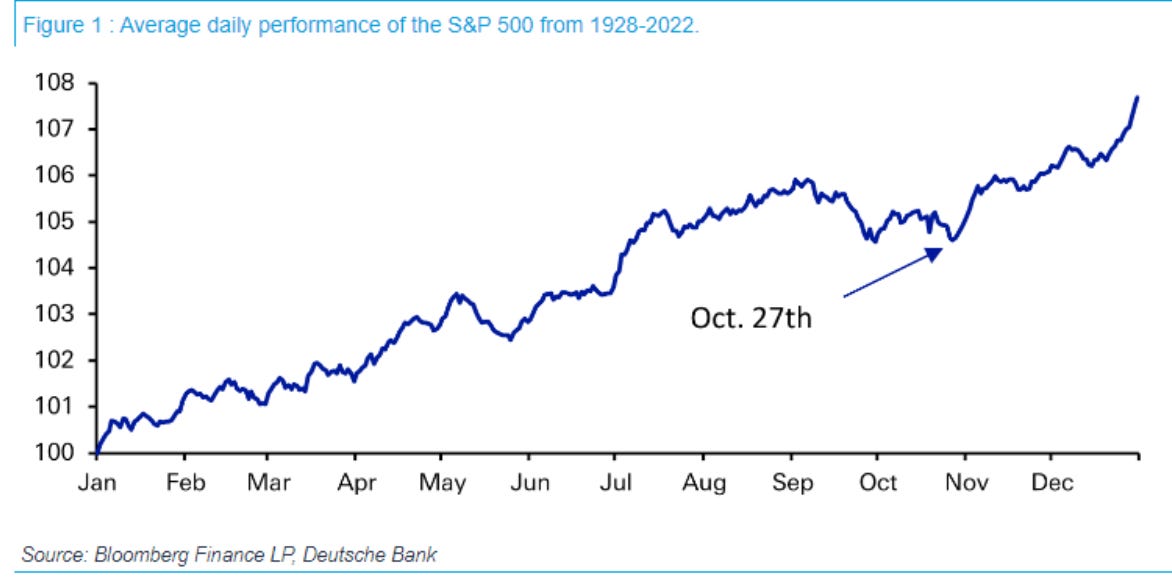Making Hay Monday - October 30th, 2023
High-level macro-market insights, actionable economic forecasts, and plenty of friendly candor to give you a fighting chance in the day's financial fray.
Charts of the Week
This year has not brought the typical October rally. That may be a function of the gravitational pull from dramatically higher long-term Treasury yields. It could also be the result of a rising number of disappointing earnings reports (though there have also been some high- profile positive surprises, such as Amazon). Because stocks and bonds are both seriously oversold, a near-term bounce is probable. As you can see in the Jim Reid/Deutsche Bank visual below, the seasonal tendency for stocks to perk up between now and the end of the year is impressive. Consequently, doing a bit of buying now, while retaining a considerable cash reserve, is reasonable.
Oil prices have failed to sustain their initial spike in the immediate aftermath of the heinous attack by Hamas on Israeli citizens. Fortunately, so far, this has only led to sporadic attacks by Iranian proxies. Regardless, in the near future, the Biden administration may turn its attention to the 1.5 million barrels/day that Iran is exporting over its sanction limits. This is despite the former’s desire to prevent gasoline prices from surging during the year leading up to the next U.S. presidential election.
“Last week represented a tipping point in the relationship between financial markets and the US economy. Instead of strong economic and earnings data sending stocks higher and bonds lower, the opposite occurred. The key catalyst was earnings outlooks. The breadth of disappointing earnings guidance was so prevalent, it was hard to miss.” -JonesTrading’s Mike O’Rourke
“… things always change, it’s simply our reluctance to accept that inconvenient truth that causes us problems. And, while that’s a trait common to humanity in every area of its existence, perhaps nowhere is that truer or more dangerous than in the world of finance.” -Friend of the Haymaker, Grant Williams
The Boom Before the Gloom?
These are unquestionably strange times. Third quarter U.S. economic growth appears to be coming in between 4% and 5%. Either is an exceedingly vibrant reading. Yet, the stock market is cracking, and at a time of the year when it is typically in rally mode.
It’s certainly possible that the usual October rally is simply being delayed by the agony in the long-term Treasury bond market. It’s also highly likely that a vigorous recovery in U.S. Treasurys (USTs) should produce a snapback in stocks. Based on the highly oversold status of USTs, that’s a distinct possibility.
However, a more enduring rally in extended maturity USTs is challenged by the abovementioned economic buoyancy. Moreover, that 4% to 5% growth rate is exclusive of inflation. This is the standard “real GDP” statistic. Including inflation, otherwise known as nominal GDP, the number is in the 7% to 8% range, potentially even higher.
Last week, while on “vacation”, I listened to a podcast by my great mate Grant Williams, who, coincidentally, graciously hosted my wife and our youngest son’s family on lovely Kiawah Island, South Carolina. Grant recently recorded an interview with one of the smartest macroeconomic thinkers I know of, James Aitkin. In it, James repeatedly made the case that nominal GDP is what truly matters when it comes to economic activity. In his view, it’s the quantity of dollars coursing through the economy’s system that dictates factors such as consumer confidence and Corporate America’s hiring and investing plans.
Similarly, another brainy financial media type, Ben Hunt, observed that when you’ve got 8% nominal GDP growth, it’s totally inconsistent with the Fed’s 2% inflation target. In other words, perhaps the stock market’s recent travails are a function of too much of a good thing.
That’s certainly possible as this situation puts upward pressure on long-term interest rates. It also makes the Fed much less inclined to engage in what almost all of Wall Street is yearning for: the start of an interest rate cutting cycle.
In reality, that’s as unhelpful to stocks and the economy as the un-inversion of the yield curve. History is clear: When the Fed begins aggressively easing, which in turn causes the yield curve to normalize (short rates falling back below long rates), the really serious trouble for stocks and the economy ensues.
For now, though, due to the strength of the third quarter’s economic numbers, “higher for longer” is a potentiality about which stock market bulls are beginning to have an uncomfortable epiphany. The normalization of the yield curve is also not going according to their plans. Instead of that happening due to falling short rates in response to aggressive Fed easing (think 2002 and 2007), the un-inversion has been a result of the radical rise by longer rates. This is a so-called “bear steepener” because it reflects a bear market in long bonds. That’s definitely not the outcome for which bulls have been ardently hoping.
Consequently, I’m in an odd situation. This is because I remain extremely skeptical the economy is nearly as virile as the government bean counters believe it is. Maybe I’m just being stubborn, but when I look at most of the earnings reports coming out for the third quarter they don’t look all that toasty. In fact, a growing number look to be quasi-recessionary.





